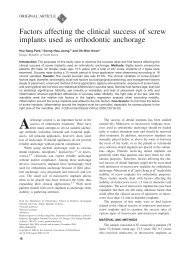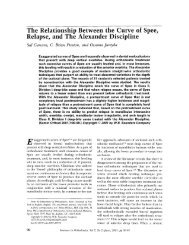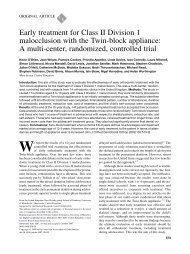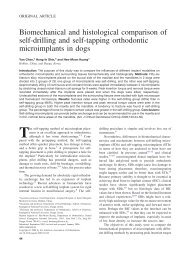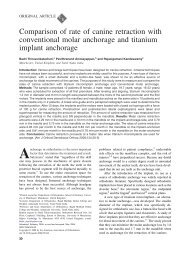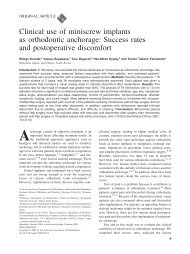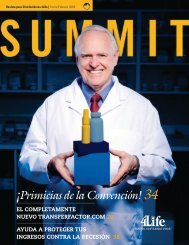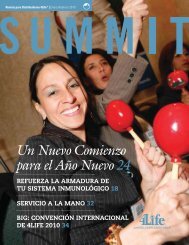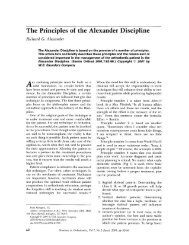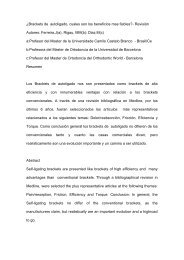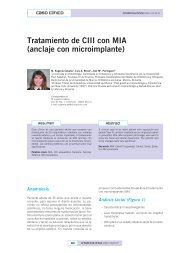Leveling the curve of Spee with a continuous archwire technique: A ...
Leveling the curve of Spee with a continuous archwire technique: A ...
Leveling the curve of Spee with a continuous archwire technique: A ...
You also want an ePaper? Increase the reach of your titles
YUMPU automatically turns print PDFs into web optimized ePapers that Google loves.
American Journal <strong>of</strong> Orthodontics and Dent<strong>of</strong>acial Orthopedics<br />
Volume 131, Number 3<br />
Table III. Cephalometric measurements from T1 to T3<br />
Measurement<br />
Treatment changes<br />
(T1-T2)<br />
to <strong>the</strong> mandibular plane (Tables III and IV) were<br />
statistically significant (P .01).<br />
After <strong>the</strong> relevant age- and sex-related mean growth<br />
increments were added to <strong>the</strong> data, <strong>the</strong> following results<br />
Posttreatment changes<br />
(T2-T3)<br />
Total change<br />
(T1-T3)<br />
Mean SD Mean SD Mean SD<br />
L4-COS line (mm) 2.50 0.77 0.49 0.69 1.78 0.74<br />
L1-MP perp (mm) 0.53 1.60 1.66 2.30 2.19 2.37<br />
L4-MP perp (mm) 2.81 1.69 1.00 2.00 3.81 2.15<br />
L6-MP perp (mm) 2.31 2.28 1.23 2.38 3.53 2.24<br />
L1-MP perp: growth (mm) 0.87 0.66 0.21<br />
L4-MP perp: growth (mm) 1.26 0.00 1.26<br />
L6-MP perp: growth (mm) 0.61 0.23 0.84<br />
L1-MP (°) 0.82 6.08 1.18 5.21 0.35 3.91<br />
L1 to A-Po (mm) 1.51 1.57 0.10 1.31 1.41 1.57<br />
L1-NB (°) 1.37 4.81 1.03 4.21 0.34 4.35<br />
SNA angle (°) 2.65 2.17 0.37 2.23 2.27 2.51<br />
SNB angle (°) 0.34 1.29 0.55 1.34 0.89 1.58<br />
ANB angle (°) 2.98 1.55 0.18 2.06 3.16 2.34<br />
Wits (mm) 0.52 1.86 0.06 1.45 0.59 1.95<br />
Y-axis (°) 1.05 1.34 0.34 1.33 0.71 1.73<br />
SN-MP (°) 0.98 2.43 0.56 2.44 0.42 2.75<br />
SN-OP (°) 2.98 3.09 0.19 2.56 3.18 3.22<br />
OP-MP (°) 3.90 3.83 0.32 3.14 3.58 3.18<br />
SN-PP (°) 0.95 1.91 0.73 1.64 0.23 1.78<br />
U6-MP perp (mm) 2.73 2.85 1.24 1.59 3.97 2.56<br />
U6-MP (°) 2.11 5.32 2.11 5.40 4.23 5.67<br />
U1-PP perp (mm) 0.58 1.99 1.42 1.79 2.00 2.20<br />
U1-PP (°) 1.98 9.29 0.74 5.22 2.73 9.00<br />
U1-NA (°) 3.50 8.09 1.00 3.92 4.50 7.24<br />
U1-L1 (°) 3.70 11.37 0.82 6.55 2.92 10.28<br />
L6-MP (°) 6.42 3.04 1.87 4.63 4.55 5.37<br />
Perp, Perpendicular.<br />
Table IV. Paired t tests for cephalometric measurements<br />
Measurements T1 vs T2 T2 vs T3<br />
COS P .0001 P .0004<br />
L1 perp to MP P .0742 P .0004<br />
L4 perp to MP P .0001 P .0093<br />
L6 perp to MP P .0001 P .007<br />
L1 perp to MP, growth P .0052 P .0001<br />
L4 perp to MP, growth P .0001 P .0627<br />
L6 perp to MP, growth P .1482 P .0001<br />
L1 to MP P .4569 P .2181<br />
L1 to A-Po line P .0001 P .6829<br />
L1 to NB P .1227 P .1822<br />
SN-MP P .0316 P .2072<br />
Y-axis P .0001 P .1651<br />
OP-MP P .0001 P .5151<br />
SN-OP P .0001 P .6769<br />
SN-PP P .0095 P .0198<br />
ANB angle P .0001 P .6357<br />
Perp, Perpendicular.<br />
Bernstein, Preston, and Lampasso 367<br />
were recorded. The mean adjusted (T2-T1) changes for<br />
L1-MP and L4-MP (Tables III and IV) were statistically<br />
significant (P .0052). The mean treatment<br />
changes allowing for growth were –0.87 mm for<br />
L1-MP, 1.26 mm for L4-MP, and 0.61 mm for L6-MP.<br />
The negative value calculated for <strong>the</strong> incisor represents<br />
relative intrusive movement over this time period. The<br />
posttreatment (T3-T2) changes for L1-MP and L6-MP<br />
adjusted for growth were statistically significant (P <br />
.0001). The mean net posttreatment dental movements,<br />
taking growth into account, were 0.66 mm for L1-MP,<br />
0.00 mm for L4-MP, and 0.23 mm for L6-MP.<br />
At T2, <strong>the</strong> mean increase in mandibular incisor<br />
inclination to <strong>the</strong> mandibular plane was 0.82° (SD, <br />
6.08°) (Table III). The mean amount <strong>of</strong> relapse (T3-T2)<br />
was –1.18° (SD, 5.21°). A negative number represents<br />
lingual movement (uprighting) <strong>of</strong> <strong>the</strong> mandibular<br />
incisors relative to <strong>the</strong> MP. The overall effect (T3-T1)<br />
on <strong>the</strong> mandibular incisor inclination to <strong>the</strong> MP was<br />
–0.35° (SD, 3.91°).<br />
Associated <strong>with</strong> orthodontic treatment, <strong>the</strong> mandibular<br />
incisors advanced a mean distance <strong>of</strong> 1.51 mm<br />
(SD, 1.57 mm) relative to <strong>the</strong> A-Po line (Table III).




